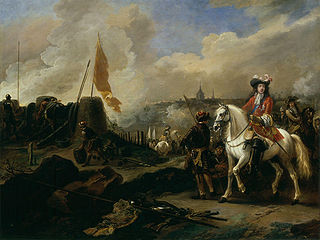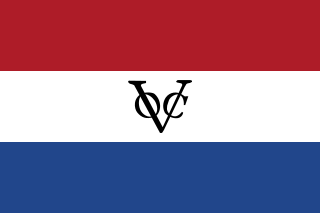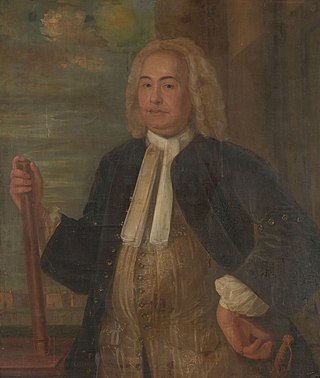Related Research Articles

1685 (MDCLXXXV) was a common year starting on Monday of the Gregorian calendar and a common year starting on Thursday of the Julian calendar,the 1685th year of the Common Era (CE) and Anno Domini (AD) designations,the 685th year of the 2nd millennium,the 85th year of the 17th century,and the 6th year of the 1680s decade. As of the start of 1685,the Gregorian calendar was 10 days ahead of the Julian calendar,which remained in localized use until 1923.

Gustaaf Willem,Baron van Imhoff was a Dutch colonial administrator for the Dutch East India Company (VOC). He served as Governor of Ceylon from 1736 to 1740 and as Governor-General of the Dutch East Indies from 1743 until his death in 1750 at Istana Cipanas.

Dutch Ceylon was a governorate established in present-day Sri Lanka by the Dutch East India Company. Although the Dutch managed to capture most of the coastal areas in Sri Lanka,they were never able to control the Kingdom of Kandy located in the interior of the island. Dutch Ceylon existed from 1640 until 1796.

The Nayaks of Kandy were the rulers of the Kingdom of Kandy between 1739 and 1815,and the last dynasty to rule on the island. The term Nayak is derived from the Sanskrit word Nāyaka. Their rise to power came about as a result of the death of Vira Narendrasinha,who left no legitimate heir- the throne passed to his brother-in-law,who was crowned as Sri Vijaya Rajasinha in 1739. They were of Telugu Balija origin,spoke Telugu and Tamil,and used Sinhala and Tamil as their court languages. They are also credited for building various Vishnu temples in Sri Lanka dedicated to their clan deity Vishnu,known as Upulvan in Sinhala. A prominent one of them was the Kandy Vishnu Temple established at their capital Kandy. A cadet branch of the Madurai Nayak dynasty,the Kandyan Nayaks were related to the Thanjavur Nayaks as well. Both Madurai and Thanjavur nayaks belonged to Balija caste.

The Kingdom of Kandy was a monarchy on the island of Sri Lanka,located in the central and eastern portion of the island. It was founded in the late 15th century and endured until the early 19th century.

Johannes Thedens was Governor-General of the Dutch East Indies from 6 November 1741 until 28 May 1743.

VOC opperhoofden in Japan were the chief traders of the Dutch East India Company in Japan during the period of the Tokugawa shogunate,also known as the Edo period.

Kirti Sri Rajasinha was the second Nayaka king of Kandy. He was a prince from the Madurai Nayak Dynasty and the brother-in-law of Sri Vijaya Raja Singha. He succeeded his brother-in-law to the throne in 1751.

Joan Gideon Loten was a Dutch servant in the colonies of the Dutch East India Company,the 29th Governor of Zeylan,Fellow of the Royal Society and Fellow of the Society of Antiquaries of London. During his time in the colonies he made collections of natural history. In 1758 he moved to Holland. Nine months after his return from the Dutch East Indies he moved to London,where he lived for 22 years and interacted with scholarly societies and shared his natural history illustrations and collections. The sunbird species Cinnyris lotenius is named after him

The MahâAdigâr was a Great Officer in the Amātya Mandalaya,or Sinhalese Council of State,in the Sinhalese Kingdoms of monarchical Sri Lanka. The office was second in power and dignity to the King. Like many of the existing high offices at the time it had combined legislative and judicial powers and functioned primarily equivalent to that of a prime minister and chief justice,but also had duties in the governance of a province. During the Kandyan period there were two Adigars,who were styled MahâNilames,the PallegampahêMahâNilamêand the UdagampahêMahâNilamê,the former taking precedence over the latter.
Van Eck is a Dutch toponymic surname. The name can be derived from Van Heck or van eik,but perhaps most families,including the noble family (Van Panthaleon) Van Eck,find their origin in the town Eck in Gelderland,first mentioned in the year 953. People with this surname include:
Joan Paul Schaghen was an acting Governor of Ceylon in 1725 and 1726 and director-general of the council of the Dutch East India Company in Batavia from 1737 to 1741.
Jan Schreuder was the 30th Governor of Zeylan during the Dutch period in Ceylon. He was appointed on 17 March 1757 and was Governor until 17 September 1762. He was succeeded by Lubbert Jan baron van Eck.

Sinhalese–Portuguese conflicts refers to the series of armed engagements that took place from 1518 to 1658 in Sri Lanka between the native Sinhalese and Tamil kingdoms and the Portuguese Empire. It spanned from the Transitional to the Kandyan periods of Sri Lankan history. A combination of political and military moves gained the Portuguese control over most of the island,but their invasion of the final independent kingdom was a disaster,leading to a stalemate in the wider war and a truce from 1621. In 1638 the war restarted when the Dutch East India Company intervened in the conflict,initially as an ally of the Sinhalese against the Portuguese,but later as an enemy of both sides. The war concluded in 1658,with the Dutch in control of about half the island,the Kingdom of Kandy the other half,and the Portuguese expelled.

The Star Fort is a fort in Matara,Sri Lanka,located on the eastern bank of the Nilwala River,approximately 350 metres (1,150 ft) from the gate to the Matara fort. It was constructed by the Dutch in 1765,and was originally called Redoute Van Eck.

Coffee production in Sri Lanka peaked in 1870,with over 111,400 hectares being cultivated. The Dutch had experimented with coffee cultivation in the 18th century,but it was not successful until the British began large scale commercial production following the Colebrooke–Cameron Commission reforms of 1833. By 1860,the country was amongst the major coffee-producing nations in the world. Although coffee production remains a source of revenue,it is no longer a main economic sector. In 2014,the country ranked 43rd of largest coffee producers in the world.

The Dutch-Kandyan War of 1670–1675 emerged as a result of territorial ambitions on the part of the Dutch,who sought to extend their dominion. The conflict saw French involvement,potentially at Rajasinha's invitation,although they were ultimately ousted. Consequently,the Dutch managed to expand their territorial holdings,successfully achieving their objectives.

The Dutch-Kandy War of 1764-1766 marked a military conflict between the Dutch East India Company and the Kingdom of Kandy,culminating in the occupation of Kandy by Dutch forces and the subsequent transfer of the entire coastal territory of Sri Lanka to Dutch control.
References
- 1 2 A Vrugt, Inventary of the archive of Lubbert Jan, Baron van Eck [usurped] , Dutch National Archive, 1990. It contains a biography on page 9, and a description of his acts as governor from page to 15